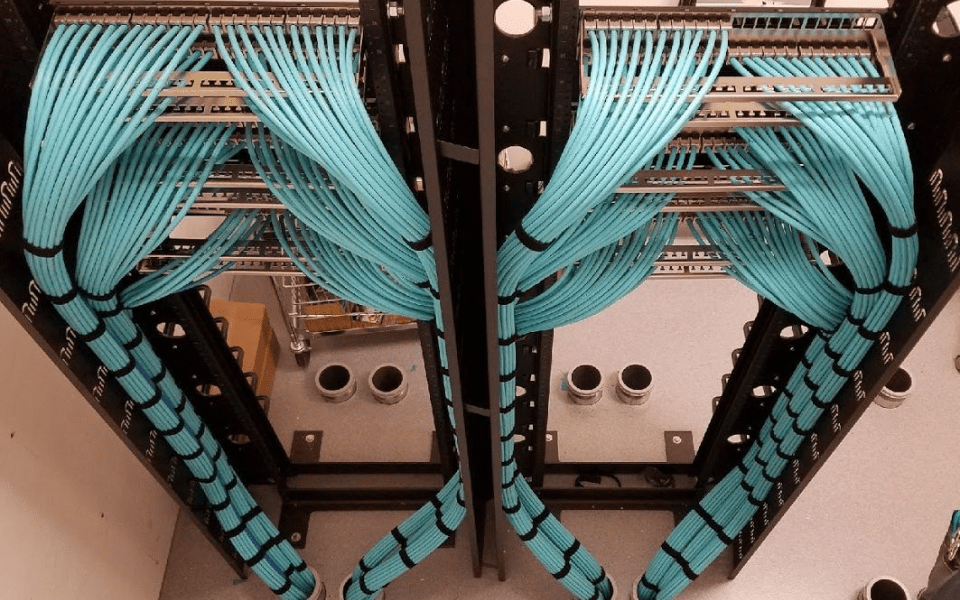Structured Cabling for Coeur d’Alene & Spokane | Network & Data

Intechtel is your trusted structured cabling partner for network and data cabling projects in the Inland Northwest. Serving businesses of all sizes, we deliver superior service, exceptional workmanship, and unmatched support. We know reliable network wiring is crucial to your organization, which is why we stand behind our work with a full guarantee on all cable installations. Whether you need a single cable—Coax, Cat5e, Cat6, Cat7, Fiber Optic—or a complete building wired for connectivity, Intechtel has you covered. We also offer expert surveillance system cabling and installation. Same and next-day on-site service is available in Coeur d’Alene, Post Falls, Hayden, Spokane, and nearby areas.
IT Infrastructure & Cabling Services
Common Structured Cabling Projects
New + Existing Construction
Fiber Optic Installs & Repair
Network Cable Management
Structured Cabling Types and Planning
Cat5e: Reliable and Affordable Network Cabling
When planning network cabling for a new building, adding additional network drops, or remodeling where data cabling will be exposed, it’s crucial to choose structured cabling that meets both current and future needs.
Cat5e remains a widely used standard for network data cabling. A significant improvement over Cat5, it supports data transfer rates of up to 1000 Mbps (1 Gbps) over distances of up to 328 feet. This performance is achieved through tighter twists in the wire pairs, reducing crosstalk and improving signal quality. Cat5e is cost-effective, easy to work with, and suitable for most small business applications.
However, as data demands continue to grow exponentially, Cat5e may not always suffice for future requirements. While costs vary by brand, investing in higher-quality structured cabling can prevent issues like poor construction or build quality, which can cause costly disruptions.
Cat6: Breaking into 10Gbps Networks
Cat6 is the modern standard for data network cabling, offering even greater performance than Cat5e. It supports data transfer rates of up to 10 Gbps at distances up to approximately 100 feet. This is achieved through tighter twists in the wire pairs and a plastic divider within the cable jacket, which reduces crosstalk and enhances signal reliability.
To maximize the performance of Cat6 cabling, it’s essential to use compatible components such as Cat6 data jacks and patch panels. While Cat6 is backward compatible with Cat5e hardware, using Cat6-rated components ensures optimal performance.
Cat6 cabling and accessories are typically more expensive than Cat5e due to higher-quality materials and a more complex manufacturing process. However, if you anticipate growing data needs, investing in Cat6 upfront is a smart decision that can future-proof your network.
Cat6a: The Gold Standard for High-Speed Networks Up to 10Gbps
Cat6a is a further enhancement of Cat6 with larger conductors, crosstalk dividers, and larger jacketing to decrease RF/EM interference. It supports data rates up to 10Gbps at the full 328ft length.
Cat6a can be either shielded or unshielded depending on the application and use case. Cat6a is frequently used for futureproofing and when a ten gigabit network will be deployed. While backwards compatible with past standards, it is important to use Cat6a jacks, modular ends, and patch cables to realize the full performance of the cable.
Cat6a and its accessories are more expensive than cat6, and requires more specialized testing equipment to certify and test. If you plan on running multi-gigabit speeds such as 2.5, 5, or 10Gbps, Cat6a is an excellent choice.
Cat8: The Newest and Fastest Copper Networking Standard
Cat8 is a newer standard that supports speeds of 25-40Gbps at a distance of up to 100ft. Cat8 is usually shielded at both the jacket AND each individual twisted pair level.
It is generally only used in datacenters and other high-performance networking applications such as Storage Area Networks (SAN.) It is not typically used in home or small/medium business environments due to its cost, and the lack of need for speeds above 10Gbps in most cases.
Cat8 usually also uses a specialized connector called a TERA connector. It is a more complex connector designed specifically for the demanding bandwidth performance surrounding cat8.
Still have questions about different cable types or want to discuss costs for your project?
Serving Spokane, Coeur d’Alene, Post Falls, and Hayden areas.
Types of Fiber Optic Cable – Installation and Repair
The key distinction between single-mode and multimode optical fiber lies in their core diameter. Multimode fiber features a significantly larger core, typically 50-100 micrometers, which allows it to carry more light. While this gives multimode fiber greater capacity, single-mode fiber excels over longer distances due to its higher fiber distance product limit. This advantage arises because single-mode transmits light in a single propagation mode, avoiding the modal dispersion that limits multimode fiber.
Single-mode fiber is ideal for long-distance applications, such as connecting cities or states. In contrast, multimode fiber is primarily used for inside plant infrastructure. At Intechtel, we specialize in the installation and repair of both single-mode and multimode fiber optic cabling, providing solutions for both inside and outside plant needs.
📞 Phone: 208.635.4400
📧 Email: [email protected]
Serving Spokane, Coeur d’Alene, Post Falls, and Hayden areas.

Need Fully Managed IT Support? IT Support Plans ➝
Partnering with a Managed IT Service Provider (MSP) ensures your business has expert, local support for all its tech needs. MSPs provide predictable, scalable costs and proactive monitoring, helping businesses avoid costly emergencies and operational inefficiencies. They also enhance security through layered protections, employee training, and real-time problem resolution, giving you peace of mind and freeing your team to focus on their core responsibilities.

Real Customer Stories Coeur d'Alene Public Golf Course ➝
The Coeur d'Alene Public Golf Course was operating with outdated infrastructure that struggled to meet the needs of their day-to-day operations. They were dealing with unreliable WiFi, an aging analog paging system, and a legacy phone system that was difficult to manage and update — especially when seasonal schedules and events demanded frequent changes. Their goals were clear...read more.


